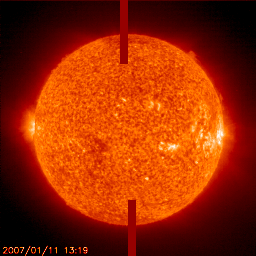Detecting Gravitational Waves and Solar g-modes
There is a concentrated effort to detect the solar g-modes by using direct observations of the electromagnetic (EM) spectrum, combined with theoretical considerations. Thus far, there have been some reports of direct detection, however, these currently remain unsubstantiated. Furthermore, since experimentalists are edging towards the limitations of this technology, it is enforcing scientists to consider alternative detection techniques.
One such alternative is to detect the gravitational wave spectrum, which is predicted to be emitted by solar g-modes at very low frequencies of less than 400 µHz. There are several terrestrial gravitational wave detectors which are operational, however, the inherent seismic vibrations of the Earth renders them impractical within this frequency range. Therefore, detectors for this purpose must be deployed for outer space.
There are two primary concepts under development. The Astrodynamical Space Test of Relativity using Optical Devices (ASTROD) and the Laser Interferometer Space Antenna (LISA). One of the most important factors required for confident detection is that the g-mode surface velocities be large enough such that the consequent gravitational wave signature resides well above the detector noise.
There is 1 observational constraint and 2 theoretical models which will be emphasised here. Using the most up-to-date observational results from Garcia et al (2007) gives an upper limit for the g-mode surface velocities to be about 0.3 mm/s at 100 µHz. If g-modes have amplitudes of this magnitude then they are very unlikely to be detected with LISA. However, there it is still possible for ASTROD to be sucessful, since its strain sensitivity curve is shifted towards lower frequencies. The theoretical models are less convincing. The most optimistic is by Gough (1985) which also gives surface velocities of about 0.3 mm/s at 100 µHz for which only ASTROD would be capable of detection, as the signal will lie well below LISA's noise curve. Finally, the most pessimistic model is by Kumar et. al. (1996) which gives 0.1 mm/s at 200 µHz, for which the current designs of both ASTRO and LISA would be incapable of detection.
Thus, it is worth contemplating whether the orbit design for ASTROD could be modified to encompass even the most pessimistic of these models. If ASTROD's orbit were modifed to approach as close as 0.4 AU from the sun, then ASTROD will provide unambiguous detection of g-modes with frequencies between 100-300 µHz.
Raymond Burston (MPS, Katlenburg-Lindau), Laurent Gizon (MPS, Katlenburg-Lindau) & Thierry Appourchaux (IAS, Orsay).
The movie of the sun as shown above was taken from http://sohowww.nasa.gov/data/LATEST/current_eit_304.mpg
Page last updated on July 17, 2009
Latest News

